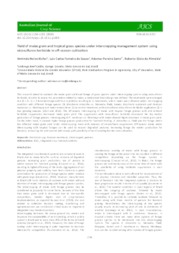Yield of maize grain and tropical grass species under intercropping management system using nicosulfuron herbicide in off-season cultivation.
Yield of maize grain and tropical grass species under intercropping management system using nicosulfuron herbicide in off-season cultivation.
Author(s): KICHEL, A. N.; SOUZA, L. C. F. de; SERRA, A. P.; ALMEIDA, R. G. de
Summary: This research aimed to evaluate the maize grain yield and forage of grass species under intercropping system using nicosulfuron herbicide. In order to assess the parameters related to maize, a randomized block design was defined. The treatments were arranged in a (5 × 2+ 1) × 2 factorial design with four repetitions resulting in 11 treatments, where maize was cultivated under intercropping condition with different forage species (5) (Brachiaria brizantha cv. Marandu, Piatã, Xaraés, Brachiaria ruziziensis and Panicum maximum cv. Mombaça) and maize monoculture (1) as control treatment, with and without nicosulfuron herbicide application (2) in two growing seasons (2014 and 2015). The off-season intercropping of maize with tropical forage grasses with and without herbicide suppression decreased maize grain yield. The suppression with nicosulfuron herbicide decreased the dry matter production of forage grasses. Intercropping of P. maximum cv. Mombaça with maize showed higher decrease in maize grain yield. On the other hand, it showed higher forage grasses production for livestock feeding. B. brizantha cv. Piatã was the forage which less affected maize grain yield under intercropping, even with absence of nicosulfuron suppression. Off-season maize under intercropping with tropical forages can be used to recover degraded pastures; increasing forage dry matter production for livestock, remaining the soil covered with straws with possibility of no-till seeding for the next cultivation.
Publication year: 2019
Types of publication: Journal article
Unit: Embrapa Beef Cattle
Keywords: Brachiaria sp, Milho, Panicum Maximum, Pastagem, Pastures
Observation
Some of Embrapa's publications are published as ePub files. To read them, use or download one of the following free software options to your computer or mobile device. Android: Google Play Books; IOS: iBooks; Windows and Linux: Calibre.
Access other publications
Access the Agricultural Research Database (BDPA) to consult Embrapa's full library collection and records.
Visit Embrapa Bookstore to purchase books and other publications sold by Embrapa.

